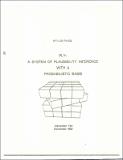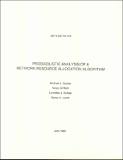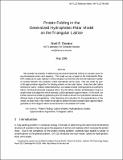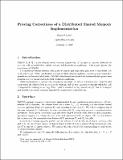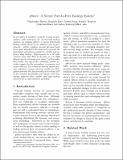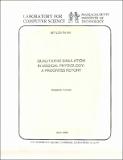Browsing LCS Technical Memos (1974 - 2003) by Title
Now showing items 345-364 of 492
-
PLY: A System of Plausibility Inference with a Probabilistic Basis
(1982-12)An overview is given of a system of plausibility inference that will be developed for use in planning. This system, to be called PLY, will be specifically designed to work with propositions of the form "when A is true ... -
The Power of Team Exploration: Two Robots Can Learn Unlabeled Directed Graphs
(1995-09)We show that two cooperating robots can learn exactly any strongly-connected directed graph with n indistinguishable nodes in expected time polynomial in n. We introduce a new type of homing sequence for robots, which helps ... -
The Power of the Queue
(1986-04)Queues, stacks (pushdown stores), and tapes are storage models which have direct applications in compiler design and the general desig of algorithms. Whereas stacks (pushdown store or last-in-first-out storage) have been ... -
A Principled Design for an Integrate Computational Environment
(1982-07)Boxer is a computer language designed to be the base of an integrated computational environment providing a broad array of functionality -- from text editing to programming -- for naïve and novice users. It stands in the ... -
Probabilistic Analysis of a Network Resource Allocation Algorithm
(1985-06)A distributed algorithm is presented, for allocating a large number of identical resources (such as airline tickets) to requests which can arrive anywhere in a distributed network. Resources, one allocated, are never ... -
Probabilistic Searching in Sorted Linked Lists
(1983-11)Janko [2] and Bentley, Stanat, and Steele [1] have described probabilistic procedures for data manipulation in sorted linnked lists. Their procedures are based on an algorithm which performs a Member search operation using ... -
A Program for Therapy of Acid-base and Electrolyte Disorders
(1983-06)This thesis describes work done on the therapy component of an on-going project for the diagnosis and management of acid-base and electrolyte disoders. Therapeutic interventions can be classified as symptomatic or etiologic, ... -
Proposal for a Small Scheme Implementation
(1984-10)Scheme is a lexically scoped dialect of LISP developed at MIT. In this report we determine the feasibility of implementing a Scheme-based programming/application environment on a contemporary personal computer such as the ... -
The Propositional Dynamic Logic of Deterministic, Well-Structured Programs
(1981-03)We consider a restricted propositional dynamic logic, Strict Deterministic Propositional Dynamic Logic (SDPDL), which is appropriate for reasoning about deterministic well-structured programs. In contrast to PDL, for which ... -
Protein Folding in the Generalized Hydrophobic-Polar Model on the Triangular Lattice
(1996-05)We consider the problem of determining the three-dimensional folding of a protein given its one-dimensional amino sequence. The model we use is based on the Hydrophobic-Polar (HP) model [2] on cubic lattices in which the ... -
Protosystem I: An Automatic Programming System Prototype
(1976-07)A model of the data processing system writing process is given in terms of development stages. These stages correspond to the progression in the implementation and design process from the highest level of abstraction ... -
Proving Correctness of a Controller Algorithm for the RAID Level 5 System
Mos RAID controllers implemented in industry are complicated and difficult to reason about. This complexity has led to software and hardware systems that are difficult to debug and hard to modify. To overcome this problem ... -
Proving Correctness of a Distributed Shared Memory Implementation
(1999-1)DiSOM [3,4,2] is a distributed shared memory system that offers users an atomic collection of memory cells provided they satisfy certain well-formedness conditions. This report proves the correctness of DiSOM. The system ... -
Pseudo-random Sequences
(1970-10)The purpose of this paper is to study some notions of randomnes for infinite sequences of 0's and 1's. -
pStore: A Secure Peer-to-Peer Backup System
(2002-10)In an effort to combine research in peer-to-peer systems with techniques for incremental backup systems, we propose pStore: a secure distributed backup system based on an adaptive peer-to-peer network. pStore exploits ... -
Qualitative Simulation in Medical Physiology: A Progress Report
(1985-06)This progress report describes the current status of the application of the QSIM qualitative simulation representation and algorithm to mechanisms drawn from medical physiology. QSIM takes a qualitative description of the ... -
Qualitative Simulation of Mechanisms
(1985-04)Qualitative simulation is a key inference process in qualitative causal reasoning. However, the precise meaning of the different proposals and their relation with differential equations is often unclear. In this paper, we ...
